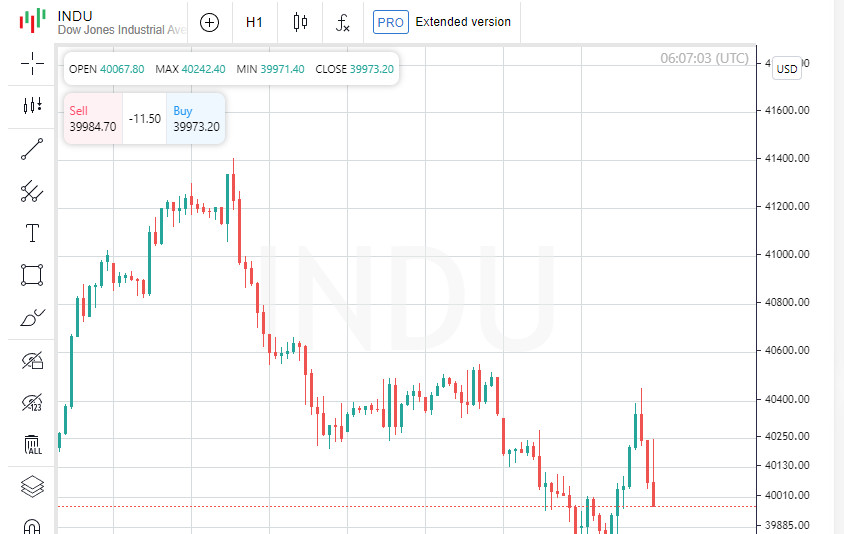
The S&P 500 and Nasdaq Composite ended a volatile session lower on Thursday, failing to recover lost ground from the previous day's tech-driven selloff. Investors struggled with uncertainty over the outlook for mega-caps.
The Dow Jones Industrial Average, on the other hand, extended its morning gains to close higher on strong U.S. gross domestic product data. Small-cap stocks also rose as investors turned away from megacaps. The Russell 2000 (.RUT) rose 1.3%, partly offsetting its mid-cap losses.
Large companies started the day with uncertainty but traded higher in the afternoon, though many of them later fell again. Microsoft (MSFT.O) and Nvidia (NVDA.O) ended the session down 1.7% to 2.4%.
Alphabet (GOOGL.O) fell for a second straight day, falling 3.1% to its lowest since May 6. Meanwhile, Tesla (TSLA.O) rose.
Weak financial results from Google's parent company and the electric car maker hurt the "Magnificent Seven" group of tech stocks on Wednesday, sending the Nasdaq (.IXIC) and S&P 500 (.SPX) to their biggest declines since 2022.
The Cboe Volatility Index (.VIX), known as Wall Street's fear gauge, extended recent gains to close at 18.46, a fresh 14-week high.
A GDP report released Thursday showed the U.S. economy grew 2.8% in the second quarter, well above expectations for a 2% rate cut by the Federal Reserve. Inflation eased and expectations for a potential Federal Reserve rate cut in September remained unchanged.
Investors are eagerly awaiting Friday's consumer spending data to confirm their belief that the Federal Reserve may soon cut rates.
While big names have driven the market to all-time highs this year, Wednesday's selloff has raised concerns that these stocks may be overextended and headed for more volatility ahead.
These concerns have prompted investors to shift money into smaller-cap stocks and other sectors outside mega-cap tech. The S&P Small Cap 600 Index (.SPCY) rose 1.4% on Thursday.
The S&P 500 Index (.SPX) fell 27.91 points, or 0.51%, to 5,399.22, while the Nasdaq Composite (.IXIC) fell 160.69 points, or 0.93%, to 17,181.72. The Dow Jones Industrial Average (.DJI) rose 81.20 points, or 0.20%, to 39,935.07.
Among stocks that saw gains on earnings reports, IBM (IBM.N) rose 4.3%, also helping lift the Dow's blue chips. The tech company beat second-quarter revenue estimates and raised its full-year growth forecast for its software business.
American Airlines (AAL.O) rose 4.2% after the company cut its full-year profit forecast. Southwest Airlines (LUV.N) climbed 5.5% after saying it would make changes such as eliminating open-plan seating and offering extra legroom seats.
The airline and logistics sector also saw gains, with Old Dominion (ODFL.O) up 5.7% and J B Hunt (JBHT.O) up 4.3%. Those moves helped lift the Dow Jones Transportation Average (.DJT) 1.3%.
Ford (F.N) shares fell 18.4% after the automaker's adjusted second-quarter profit missed analysts' expectations. Edwards Lifesciences (EW.N) fell 31.3% after second-quarter revenue fell short.
U.S. exchanges traded 13.23 billion shares, above the 11.60 billion average over the past 20 trading days.
Computer-run macro hedge funds sold $20 billion of stocks on Wednesday and plan to unload at least $25 billion more over the next week after the stocks plunged, one of the biggest risk-offs in a decade, Morgan Stanley said in a statement to institutional clients on Thursday. Following disappointing earnings reports from Tesla (TSLA.O) and Alphabet (GOOGL.O) on Wednesday, investors sold off stocks, sending the tech-heavy Nasdaq Composite Index down 3.6% for its worst day since October 2022.
"The volatility of the last two weeks began with significant rotation," the bank said, citing recent investor moves between small and mega-cap stocks. "However, this has now translated into broad-based deleveraging in the indices (on Wednesday)."
Morgan Stanley warned in a note that if volatility continues in the coming days, the sell-off could intensify significantly. An additional 1% daily decline in global equities could trigger $35 billion in selling, while macro hedge funds could wipe out as much as $110 billion on a 3% daily decline.
The major U.S. stock indexes were up on Thursday afternoon after stronger-than-expected GDP data.
James Koutoulas, CEO of hedge fund Typhon Capital Management, told that despite Wednesday's sell-off, momentum stocks continue to trade above their intrinsic value.
He noted that historically, interest rate hikes have been followed by economic downturns.
"It appears investors are betting on a reversal of that trend," he added in a note to clients.
Hedge funds are becoming increasingly bearish, reducing their long positions, or bets on stocks going up, while maintaining or increasing bets on stocks they think could fall, according to Morgan Stanley.
Portfolio managers were mostly shorting stocks in the information technology, consumer staples and materials sectors.
Goldman Sachs also noted that its clients were increasing their short positions in so-called macro products such as large-cap exchange-traded funds and corporate bonds (ETFs).
Hedge funds ended Wednesday with losses after a big drop in markets, though they generally managed to mitigate losses relative to the major stock indexes.
Global hedge funds lost an average of 0.67%, according to Morgan Stanley, with long/short equity hedge funds in the Americas seeing the biggest decline at 1.04%.
The MSCI All Country World Index (.dMIWD00000PUS) fell 1.67% on Wednesday, while the S&P 500 (.SPX) fell 2.31%.
"Hedge funds are seeing the biggest decline in an otherwise positive year," said Mario Unali, head of investment advisory at Kairos Partners.
 English
English 
 Русский
Русский Bahasa Indonesia
Bahasa Indonesia Bahasa Malay
Bahasa Malay ไทย
ไทย Español
Español Deutsch
Deutsch Български
Български Français
Français Tiếng Việt
Tiếng Việt 中文
中文 বাংলা
বাংলা हिन्दी
हिन्दी Čeština
Čeština Українська
Українська Română
Română

